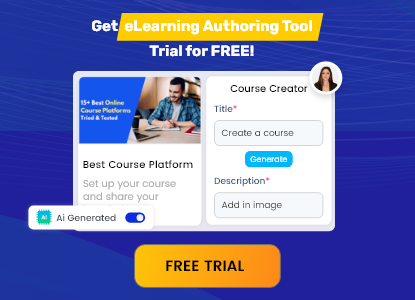In today’s world, organizations aim to create engaging, learner-focused employee learning. It involves a well-thought-out L&D plan aligned with business goals, relevant content, and easily digestible formats. Traditional lengthy learning sessions held annually or semi-annually no longer suffice in a fast-paced digital work environment with short attention spans.
Many organizations are adopting microlearning to support employees in achieving their professional goals while managing daily workloads. This approach delivers brief, focused learning sessions that gradually build skills and knowledge.
In this blog, we’ll define microlearning, discuss its advantages and challenges, provide best practices for creating a successful strategy, and more. It’s all about helping employees learn efficiently and effectively.
What Is Microlearning?
It is about breaking down your lessons into tiny, bite-sized pieces. Instead of long, vast lessons, you create small ‘learning bites,’ each focusing on a single topic.
The great thing about microlearning is that it tackles the issue of learners’ short attention spans. Even if your content is fascinating, learners need more time to focus on lengthy lessons. That’s just how our minds work.
It solves this problem by making lessons much shorter. Instead of hours, microlearning sessions last for just one, two, five, or ten minutes. It’s easier to stay engaged for a few minutes than an hour or more. This approach respects learners’ limited attention and helps them absorb information effectively.
How does microlearning function?
It isn’t just about shorter courses; it’s a shift from traditional courses. Instead, think of it as resources employees can access when needed. It’s like having a toolbox of knowledge you can use whenever required.
Compared to more extended learning, which is easy to forget, its resources are always available. For instance:
- A quick tutorial for new employees to learn your point-of-sale system.
- A library of short videos for common workplace tasks.
- Fun quizzes and information nuggets in an app to encourage healthy habits.
- Brief videos and quizzes for new product or service introductions.
- Small, on-demand modules to master advanced job-related skills.
It is most effective when short and focused on one specific thing. For more complex or collaborative topics, in-person learning may still be needed. Different types of employee learning have their benefits, which we’ll explain in another post. The key is to have the right tool for the job, whether it’s quick microlearning or more comprehensive learning.
Let's see how CogniSpark and Its features help you
This is an eLearning authoring tool that helps create microlearning courses within minutes. It simplifies user engagement and learning with its intuitive interface and AI tools. Users can easily add images, text, videos, and voiceovers without prior training using these AI tools. The AI-powered tool ensures your courses are created automatically with only the topic and basic description given, complying with SCORM standards. You can even upload your PowerPoint slides into engaging, SCORM-compliant courses. Its unique features, like AI-generated voiceovers, screen recording, spokespersons, interactive quizzes, customizable themes, course translation, and branching scenarios, make it stand out.
Advanced Features:
- User-Friendly Interface
- AI Video Generator
- Text to Image
- Text to Speech
- AI Content Generator
- PPT to SCORM Conversion
- Screen Recorder
How will microlearning benefit To eLearning
Here are some significant benefits of using a microlearning approach in your company.
Time-Efficient Learning
Short and easily understandable courses utilize engaging formats like videos and infographics, boosting knowledge retention. Learners can quickly grasp essential concepts without disrupting their workflow.
In today’s world, organizations aim to create engaging, learner-focused employee learning. It involves a well-thought-out L&D plan aligned with business goals, relevant content, and easily digestible formats. Traditional lengthy learning sessions held annually or semi-annually no longer suffice in a fast-paced digital work environment with short attention spans.
Many organizations are adopting microlearning to support employees in achieving their professional goals while managing daily workloads. This approach delivers brief, focused learning sessions that gradually build skills and knowledge.
In this blog, we’ll define microlearning, discuss its advantages and challenges, provide best practices for creating a successful strategy, and more. It’s all about helping employees learn efficiently and effectively.
Enhance Engagement
In today’s fast-paced work environment, sustaining employee engagement in lengthy learning sessions can be challenging. It keeps employees focused with concise, engaging content that aligns with daily tasks.
Improved Knowledge Retention
It fosters better information retention by breaking down complex topics into manageable chunks. It allows learners to absorb one concept at a time, preventing cognitive overload.
Cost-Effective
It proves cost-effective due to its shorter duration. It can be created and deployed swiftly, outpacing traditional eLearning in agility and affordability.
In today’s world, organizations aim to create engaging, learner-focused employee learning. It involves a well-thought-out L&D plan aligned with business goals, relevant content, and easily digestible formats. Traditional lengthy learning sessions held annually or semi-annually no longer suffice in a fast-paced digital work environment with short attention spans.
Many organizations are adopting microlearning to support employees in achieving their professional goals while managing daily workloads. This approach delivers brief, focused learning sessions that gradually build skills and knowledge.
In this blog, we’ll define microlearning, discuss its advantages and challenges, provide best practices for creating a successful strategy, and more. It’s all about helping employees learn efficiently and effectively.
Swift Development
All microlearning formats, whether performance support tools or instructional videos have shorter development cycles. Their brevity also simplifies updates and enhancements.
What Are The 4 Types of Microlearning?
It comes in many forms, but here are the four main types that need to be rewritten from our angle.
Micro lessons in Tiny Bites
Microlessons are super short lessons that break down complex topics into bite-sized pieces. They’re flexible, allowing your learners to access them whenever they want, making learning quicker, more memorable, and enjoyable.
Interactive Elements
Adding Interactive elements into your courses like AI-generated voiceovers, screen recording, spokespersons, interactive quizzes, customizable themes, course translation, and branching scenarios keeps your learners motivated.
Quick One-Minute Videos
One-minute videos deliver valuable insights in a short time. They’re perfect for today’s fast-paced world. These videos ensure your learners stay engaged and retain information. Accessible on various devices, they’re ideal for on-the-go learning.
What Are The Key Challenges of Microlearning?
While it offers many advantages, it does present some challenges. Let’s explore the critical challenge it brings:
Handling a Large Volume of Content
It involves creating many short pieces of content, often just 5-10 minutes long. It means more content to cover various topics.
Striking the Right Content Balance
Balancing shortness and informativeness in microlearning can be tricky. Subject matter experts must carefully curate content to make it concise yet rich in essential information for learners.
Customizing Content at Scale
It can result in numerous modules for a single learning course. Given its volume, personalizing and directing this content to specific individuals can be daunting.
Top 5 Best Practices of Microlearning
Make It Mobile-Friendly
Ensure that your microlearning content is optimized for mobile devices. Consider how learners use their phones and create accordingly prioritizing user-friendliness. This way, learners can focus on the learning content without grappling with complex tools.
Harness the Power of Microlearning Videos
These Microlearning videos are brief, targeted videos designed to convey specific learning objectives. They can function as standalone lessons or as components of larger microlearning courses. These videos, filled with engaging and interactive content, significantly enhance memory retention.
Cultivate Engagement
Compelling content acts as a magnet, drawing learners in. Use storytelling, real-life examples, and case studies to captivate your audience’s interest. It’s vital to understand that microlearning should never be dull. If your content fails to engage learners, they may seek out your competitors for more exciting courses.
Incorporate Infographics
Infographics, a traditional tool in instructional design, offer bite-sized educational resources that focus on crucial information. They present key points and visually represent relevant knowledge or skills, enabling learners to acquire new competencies.
Keep It Concise
Modern learners are overwhelmed and impatient. Lengthy, irrelevant content turns them off. Ideal courses should last 2-5 minutes, delivering key points briefly and reinforcing learning with micro-assessments.
What Is the Role of the Authoring Tool in Microlearning?
Using a authoring tool for creating microlearning courses should be straightforward and enjoyable. Here’s how to get started: Begin by registering for an account on the platform. Many offer free trials, like CongiSpark. Once you have an account, log in to start creating courses for free.
Look for a Microlearning Authoring Tool with various AI tools for product learning courses. Start by introducing your product professionally, using text, images, and videos. Having a wide range of options in your authoring tool helps keep your learners engaged.
Reinforce your learning with engaging activities. These can include multiple-choice questions, matching product relationships, vocabulary-based questions, or numerical values. Such activities require learners to produce information actively, enhancing their understanding rather than just recognizing what’s been taught.
Conclusion
In today’s fast-paced digital world, where employees must keep up with the latest technologies, it is gaining popularity as an innovative way of learning. Unlike traditional lengthy courses, it fits perfectly into employees’ daily routines.
If you’re wondering how to start with microlearning, consider using an eLearning authoring tool like CongiSpark to create your microlearning courses. It offers short, focused, and engaging eLearning content. With the help of this tool, you can break down information into small, easy-to-digest pieces, making learning more effective.
You can schedule a free demo with CogniSpark to discover how to create bite-sized, personalized, and on-demand learning programs supported by advanced analytics. This way, you can empower your employees with the necessary knowledge in a format that suits their fast-paced work environments.





















